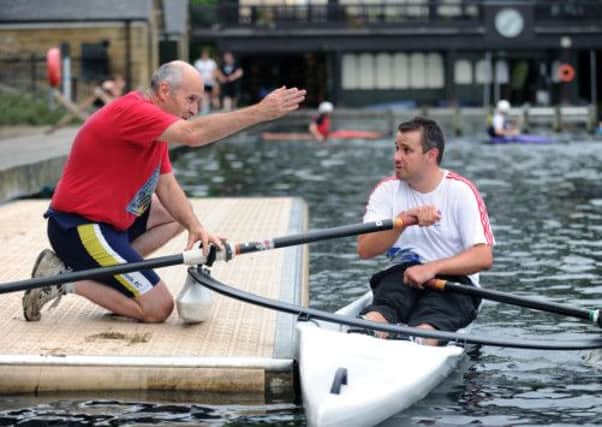Nick Westby: Rowing towards a bright future if £1m funding gets green light


As a complete novice at the helm of a boat, the agreement I struck with Leeds Rowing Club when I embarked on a participation feature with them at Roundhay Park was that under no circumstances should I capsize.
It was not an insurance issue. It was one of bravado, and of self-preservation. As hot as the weather has been, I had no desire to tumble sideways into the deep, murky blue of Roundhay Lake.
Advertisement
Hide AdAdvertisement
Hide AdFortunately, and in my defence, the stabilisers were not optional.
They are a necessity for anyone heading out on a practice boat.
Rowing is about staying afloat, being at one with the water, and much like riding a bike, you have to stay upright to progress.
But from the very start you require a little help, hence the extension to the hull of the boat provided by the stabilisers.
Advertisement
Hide AdAdvertisement
Hide AdBefore you even get near a boat, though, the first act of the opening lesson of the club’s six-hour Learn to Row scheme is on the rowing machine in their little clubhouse by the side of Roundhay Lake.
This should be a doddle, I thought. No stabilisers needed here as I bounded onto the seat, unhooked the handle and got cracking.
David Cottrell, the Leeds club’s Learn to Row instructor, stopped me before the whirring of the machine could build.
I had committed my first error, one that every person who rows a boat sees commonly in gyms up and down the country.
Advertisement
Hide AdAdvertisement
Hide AdThe actual rhythm of an oar striking the water and being lifted looks nothing like that replicated regularly on a rowing machine.
The correct stroke is more fluid, more deliberate and contains more component parts.
Fortunately, I got the hang of it pretty quickly, as I sat amongst the club rowers who blasted out a few hundred meters before heading out onto the lake in their two-man or four-man boats.
After 15 minutes of practice and armed with a new stroke, we headed to the water, which is about the time a pleasurable summer’s evening became a worry. For I had left my comfort zone behind me and as David and I walked to the pontoon with me carrying the front of the boat and he the back, the nerves began to sink in.
Advertisement
Hide AdAdvertisement
Hide AdI have never been a great sportsman, hand-eye co-ordination fails me, and I’m too heavy-footed and heavy-handed. Ham-fisted was the way one schoolteacher put it.
So as we lowered the boat into the water, one stabiliser balanced on the pontoon, the other threatening to submerge, I was asked to climb into the boat and drop gracefully onto the seat.
I got half of this routine right. The drop was executed from a little too high and I jarred every bone in my body. I did at least find the seat with my posterior, but as I sat there, gritting my teeth as the hurt subsided, that was little consolation.
And yet, that was as harrowing as it got. It turns out, I’m not that bad a rower. Because we were only concentrating on rowing with the arms and not the legs, such are the many movements you have to get right, I found the actual process not as difficult as I thought it would be.
Advertisement
Hide AdAdvertisement
Hide AdFunnily enough, I was better at rowing in circles than I was in a straight line, not that that should mean anything, but at least I was moving. And not capsizing. Once we added the raising of the knees to the moving parts of the rowing stroke, I started to get a little unco-ordinated.
“You’re doing fine,” bellowed David from the riverbank, but I was not convinced.
After a few rows around the water near the boathouse – including a nervous brush with Leeds Canoe Club who were playing a little kayak water-polo – I made it safely back to the pontoon before tumbling out of the boat about as gracefully as I had entered it.
My body was screaming. I had used muscles I didn’t know I had. My shoulders felt like they were about to burst out of my t-shirt.
Advertisement
Hide AdAdvertisement
Hide Ad